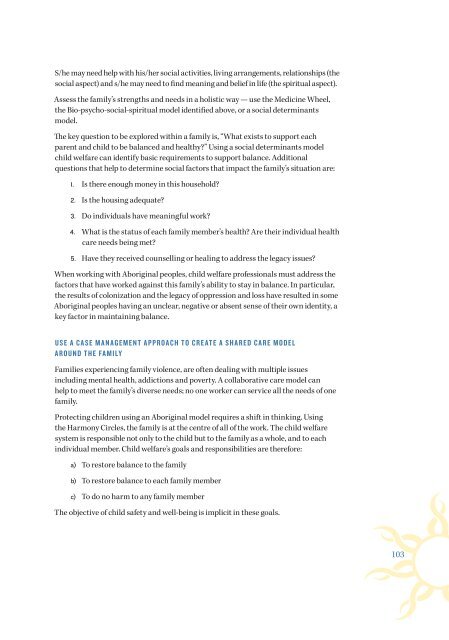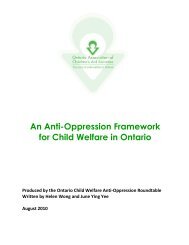English - Ontario Association of Children's Aid Societies
English - Ontario Association of Children's Aid Societies
English - Ontario Association of Children's Aid Societies
You also want an ePaper? Increase the reach of your titles
YUMPU automatically turns print PDFs into web optimized ePapers that Google loves.
S/he may need help with his/her social activities, living arrangements, relationships (the<br />
social aspect) and s/he may need to find meaning and belief in life (the spiritual aspect).<br />
Assess the family’s strengths and needs in a holistic way — use the Medicine Wheel,<br />
the Bio-psycho-social-spiritual model identified above, or a social determinants<br />
model.<br />
The key question to be explored within a family is, “What exists to support each<br />
parent and child to be balanced and healthy” Using a social determinants model<br />
child welfare can identify basic requirements to support balance. Additional<br />
questions that help to determine social factors that impact the family’s situation are:<br />
1. Is there enough money in this household<br />
2. Is the housing adequate<br />
3. Do individuals have meaningful work<br />
4. What is the status <strong>of</strong> each family member’s health Are their individual health<br />
care needs being met<br />
5. Have they received counselling or healing to address the legacy issues<br />
When working with Aboriginal peoples, child welfare pr<strong>of</strong>essionals must address the<br />
factors that have worked against this family’s ability to stay in balance. In particular,<br />
the results <strong>of</strong> colonization and the legacy <strong>of</strong> oppression and loss have resulted in some<br />
Aboriginal peoples having an unclear, negative or absent sense <strong>of</strong> their own identity, a<br />
key factor in maintaining balance.<br />
USE A CASE MANAGEMENT APPROACH TO CREATE A SHARED CARE MODEL<br />
AROUND THE FAMILY<br />
Families experiencing family violence, are <strong>of</strong>ten dealing with multiple issues<br />
including mental health, addictions and poverty. A collaborative care model can<br />
help to meet the family’s diverse needs; no one worker can service all the needs <strong>of</strong> one<br />
family.<br />
Protecting children using an Aboriginal model requires a shift in thinking. Using<br />
the Harmony Circles, the family is at the centre <strong>of</strong> all <strong>of</strong> the work. The child welfare<br />
system is responsible not only to the child but to the family as a whole, and to each<br />
individual member. Child welfare’s goals and responsibilities are therefore:<br />
a) To restore balance to the family<br />
b) To restore balance to each family member<br />
c) To do no harm to any family member<br />
The objective <strong>of</strong> child safety and well-being is implicit in these goals.<br />
103

















